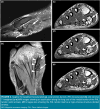A rare mass with atypical localization: Heterotopic ossification associated with flexor hallucis longus
- PMID: 39189583
- PMCID: PMC11411892
- DOI: 10.52312/jdrs.2024.1804
A rare mass with atypical localization: Heterotopic ossification associated with flexor hallucis longus
Abstract
Heterotopic ossification (HO), characterized by the formation of ectopic bone, is a benign mass observed in soft tissues. Depending on its location, it can cause symptoms beyond compression, such as mechanical blockage when associated with joints, leading to limitations in joint movements. In the majority of cases, involvement of the hip and elbow joints is common, while HO can sometimes be observed in atypical locations. Trauma, head injury, and spinal cord injuries are well-recognized risk factors for HO development. However, on rare occasions, in non-traumatic cases are identified without any known risk factors. Herein, we present a rare non-traumatic HO case associated with the flexor hallucis longus (FHL) tendon in a 58-year-old female patient. She complained of pain under the first toe of her right foot while wearing shoes for a year, and a mass was detected on the plantar surface of the foot along with limitation of movement in the first metatarsophalangeal joint. Further examinations revealed that the identified mass was a mature HO lesion. Surgical treatment was performed, and during one-year follow-up, the pain subsided, and joint movements returned to normal, resulting in a satisfactory outcome. In conclusion, although many cases of HO are associated with traumatic injuries, it can sometimes be idiopathic, as in our case, and rarely it is accompanied tendon such as FHL in the foot.
Conflict of interest statement
Figures


MRI: Magnetic resonance imaging; FHL: Flexor hallucis longus.



References
-
- Perosky JE, Peterson JR, Eboda ON, Morris MD, Wang SC, Levi B, et al. Early detection of heterotopic ossification using near-infrared optical imaging reveals dynamic turnover and progression of mineralization following Achilles tenotomy and burn injury. J Orthop Res. 2014;32:1416–1423. doi: 10.1002/jor.22697. - DOI - PMC - PubMed
Publication types
MeSH terms
LinkOut - more resources
Full Text Sources

